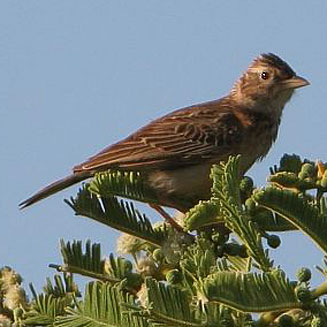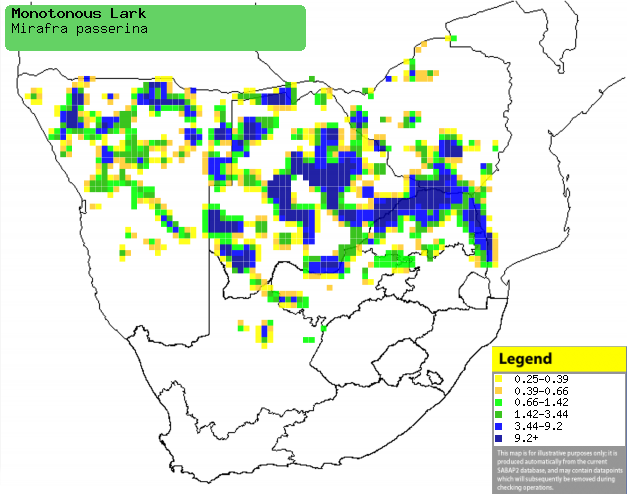|
Mirafra passerina (Monotonous
lark)
Bosveldlewerik [Afrikaans]; Yisimatuli (generic term for
lark) [Kwangali]; Mapuluhweni (generic term for lark) [Tsonga]; Sebotha
(generic term for lark) [Tswana]; Musleeuwerik [Dutch]; Alouette monotone
[French]; Sperlingslerche [German]; Cotovia-monótona [Portuguese]
Life
> Eukaryotes >
Opisthokonta
> Metazoa (animals) >
Bilateria >
Deuterostomia > Chordata >
Craniata > Vertebrata (vertebrates) > Gnathostomata (jawed
vertebrates) > Teleostomi (teleost fish) > Osteichthyes (bony fish) > Class:
Sarcopterygii (lobe-finned
fish) > Stegocephalia (terrestrial
vertebrates) > Tetrapoda
(four-legged vertebrates) > Reptiliomorpha > Amniota >
Reptilia (reptiles) >
Romeriida > Diapsida > Archosauromorpha > Archosauria >
Dinosauria
(dinosaurs) > Saurischia > Theropoda (bipedal predatory dinosaurs) >
Coelurosauria > Maniraptora > Aves
(birds) >
Order: Passeriformes > Family: Alaudidae
> Genus: Mirafra
 |
|
|
Monotonous lark, Polokwane Game Reserve, South
Africa. [photo Trevor Hardaker ©] |
|
Distribution and habitat
Near-endemic to southern Africa, occurring from southern
Angola and south-western Zambia to Zimbabwe, Botswana, Namibia and northern
South Africa. It occupies a variety of habitat types, however it generally
prefers semi-arid savanna and woodland, such as bushwillow (Combretum)
woodland, the border between miombo (Brachystegia) woodland and
vegetation along drainage lines and sparsely wooded Acacia savanna.
|
 |
|
Distribution of Monotonous lark in southern Africa,
based on statistical smoothing of the records from first SA Bird Atlas
Project (©
Animal Demography unit, University of
Cape Town; smoothing by Birgit Erni and Francesca Little). Colours range
from dark blue (most common) through to yellow (least common).
See here for the latest distribution
from the SABAP2. |
Food
It does most of its foraging on the ground, feeding on
invertebrates and grass seeds.
Breeding
- The nest is a deep cup built of dry grass and placed on the ground at the
base of or between to tufts of grass, the leaves of which are sometimes
incorporated into a dome over the nest.
- Egg-laying season is from October-March, peaking during January.
- It lays 2-4 white, heavily mottled or speckled eggs.
Threats
Not threatened.
References
-
Hockey PAR, Dean WRJ and Ryan PG 2005. Roberts
- Birds of southern Africa, VIIth ed. The Trustees of the John Voelcker
Bird Book Fund, Cape Town.
|
